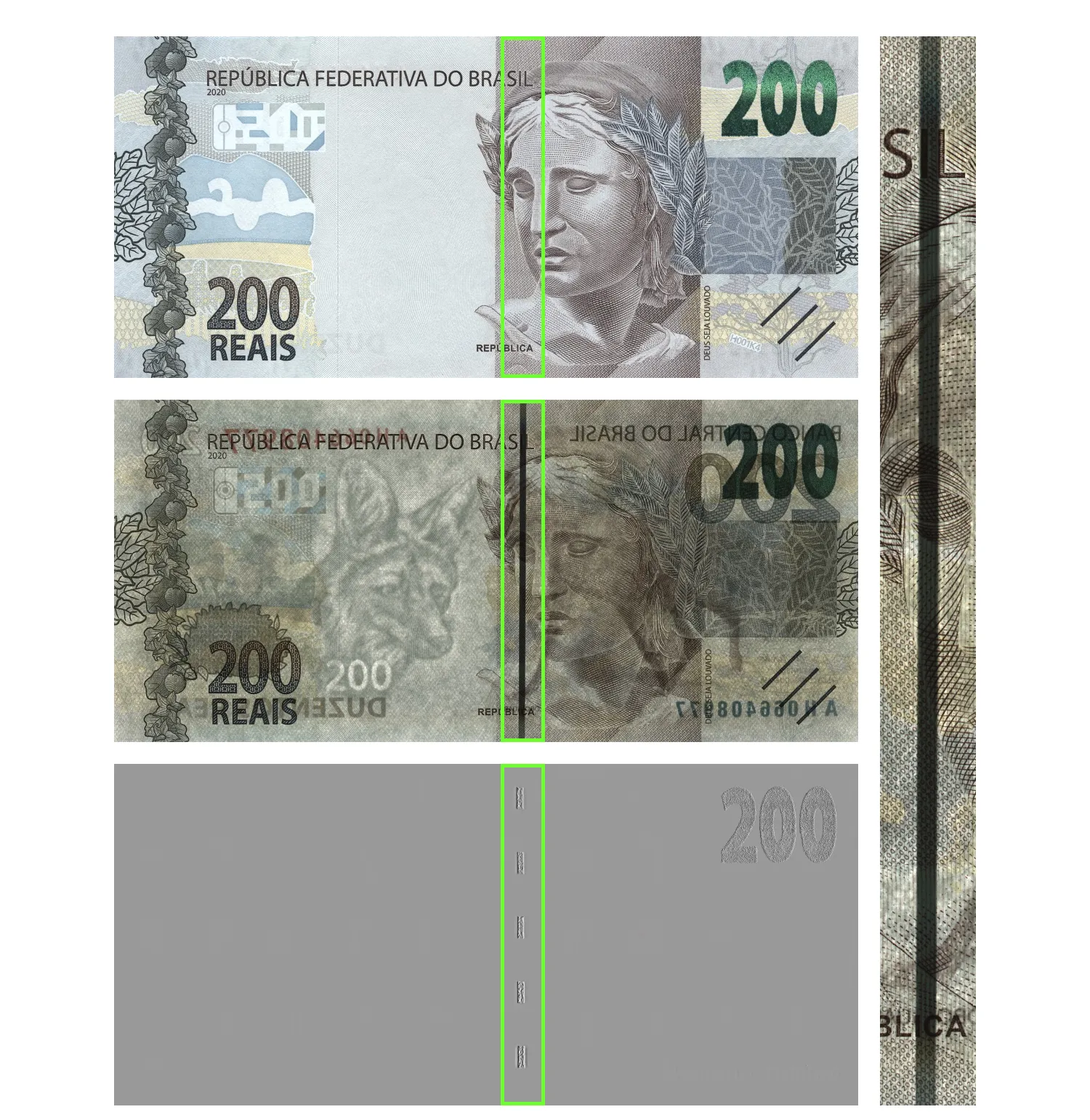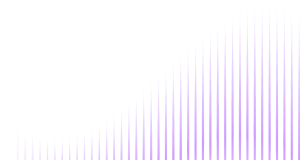There are traditional, time-tested security features commonly found in almost all banknotes, such as watermarks, security windows, anti-copy patterns, etc.
Today, let’s take a closer look at security threads—a feature that can be fully visible, partially visible, or completely invisible.
What is a security thread?
A security thread is a polymer-based stripe incorporated into banknotes during the papermaking process.
The earliest examples date back to the mid-1800s when Crane and Co. introduced silk security threads. A new era of banknote security began in the 1940s when the Bank of England proposed metallic threads for shilling banknotes. Since then, security threads have become a widely used authentication method.
Today, more than 90% of banknotes contain security threads, and their design has only become more sophisticated over the years, featuring microtexts, holograms, color-changing effects, UV luminosity, etc.
Types of security threads explained
According to their location in the paper
- Latent. A solid security thread that is completely embedded within the paper substrate. It becomes visible only when viewed in transmitted light or against natural light.
- Diving. A security thread weaves in and out, creating a dotted line on the banknote's surface. When viewed in transmitted light, the visible and hidden sections align, making the thread appear solid.
- Figure (windowed). A security thread that appears as a series of shaped windows but forms a solid line when viewed in transmitted light.

Cayman Islands Dollar from the 2010 and 2018 series. Latent security thread

Zimbabwe Gold banknote from the 2024 series. Diving security thread
Yemeni Rial from the 2017 series. Figured security thread
Get posts like this in your inbox with the bi-weekly Regula Blog Digest!
According to the material used
Metallized without text
Such security threads are foiled with a metallic luster.

Brazilian Real from the 2020 series
Metallized with microtext
Typically produced with the demetallization technique, by which inscriptions made with microtext are removed from the metallic layer of security thread by laser or chemical erasure. The security thread and microtext become visible in transmitted light.

Mexican Peso from the 2023 series
Semi-transparent with text
The base of such a security thread is transparent to the light, and opaque inscriptions are located on it.

Iranian Rial from the 2023 series
Holographic
These security threads feature holograms.
São Tomé and Príncipe Dobra from the 2020 series
Color-changing
As you tilt the note, the thread shifts between different colors, creating a color-changing effect. It is often achieved using optically variable magnetic inks (OVMI) or security features that contain diffraction gratings.
Bahamian Dollar from the 2009 series
Luminescent under UV light
Under UV light, security threads glow brightly in distinct fluorescent colors.

Cabo Verde Escudo from the 2014 series
With magnetic properties
Such security threads contain magnetic properties, which are detectable by specialized devices with magneto-optical sensors, such as the Magneto-Optical Visualizer Regula 4197.
If you are interested in learning more about magneto-optical technology for banknote authentication, don’t hesitate to read Magneto-Optics: How to Use It to Check VINs, Banknotes & Documents.

Euro from the 2017 series
With floating images that produce a motion effect
A floating image in these security threads creates a motion effect—when the note is tilted, the image appears to move or shift.
The essence of the floating effect lies in micro-optical technology. This effect is achieved using tiny lenticular lenses or micro-mirrors embedded within the thread. These optical structures manipulate light in such a way that when the banknote is tilted, the image appears to move, shift, or float above or below the surface.
United States Dollar from the 2021 series
Guernsey Pound from the 2023 series
Ghana Cedis from the 2019 and 2022 series
With a dynamic effect
The dynamic effect is a common concept for every security thread that produces motion, shifting, or transformation when the banknote is tilted or moved.
Lao Kip from the 2020 series
If you're interested in learning more about security threads in passports, don't hesitate to check Exploring Security Threads in Passports: Types, Features & Verification
What about plastic?
Since security thread is a time-tested way to protect banknotes from counterfeiting and copying, it couldn't help but migrate to more modern material options, namely plastic.
In polymer banknotes, security threads are typically printed on the surface of a polymer substrate. Hybrid banknotes, which combine paper and polymer materials, allow for more versatile security thread applications, such as partially embedded or figured (windowed) threads that interact with both substrates.
They also may contain microprinting, special inks with magnetic properties, and other security features.

Philippine Peso from the 2024 series. Polymer banknote features a semi-transparent security thread that is printed
Swiss Franc from the 2016 series. The hybrid banknote features a figured (windowed) security thread that is visible on the reverse side of the banknote
How to effectively check security threads
Various types of security threads are widely used to secure banknotes from counterfeiting. Security threads are a public means of protection and are recommended by issuing banks to verify the authenticity of banknotes by citizens of any country. Information on the security features is placed, as a rule, on the websites of the central (national) banks.
For quality examination of security threads, various methods of authenticity verification can be used, first of all, visually against white light, including via technical means. Additionally, there are devices for authenticity verification which are widely used by cash departments of banks, as well as trade and service enterprises.
Again, the main types of security threads are latent (solid, completely embedded in the paper), diving, and figured. When examining a hidden security thread, a continuous dark or translucent thread (band), usually with text, is observed. The diving-type security thread must be a perfectly regular continuous dark thread (band).

The US dollar banknote issued in 1990 and 1993. It features a latent security thread that is invisible under white light and becomes translucent under transmitted light. The security thread contains the inscription “100 USA”

Euro banknote issued in 2019, featuring a latent security thread that appears as a continuous dark band with the inscription “€100” produced using the demetallization technique

Bahraini Dinar banknote issued in 2016, featuring an invisible security thread on the front side, which appears as windows on the reverse side, and becomes a solid dark stripe under transmitted light
In addition, a multiple zoom may be useful to assess the authenticity of a diving security thread, as a characteristic torn/rough edge and paper fibers can be seen at the point where the thread “dives out,” indicating that the thread has been implemented correctly.

Modern banknotes should be tilted at different angles to reveal optical effects such as color changes, dynamic images, or a motion “floating" effect.
Color change, dynamic, and “floating" effect
If security threads have luminescent properties, the thread will glow a certain color under a UV light source.

The US Dollar series from 2003 - present
Quite often, security threads carry machine-readable authenticity features. For this purpose, materials with magnetic properties are used.
The simplest device is a detector with a magnetic head to detect the magnetic properties of materials with an audio-visual signal. More sophisticated devices are used in expert practice, such as magneto-optical visualizers and readers, which allow for performing qualitative measurements of magnetic properties.

Two-Coordinate Magneto-Optical Scanner Regula 7701M
During comparative banknote authenticity examination, it’s critical to have a reference database for information support. For example, the IRS digital catalog contains images of more than 5,000 banknotes, both in circulation and obsolete. The catalog contains images of the front and reverse sides of banknotes taken under different light sources (+ magnetic cards), as well as close-up images of security features used in banknotes.
Also, you can use more advanced hardware such as the Dual-Video Spectral Comparator Regula 4308 for research, as it has multiple zooms, bottom light sources, specialized light sources for hologram visualization, UV light sources, and other additional tools for investigating security threads.
The functionality of the video spectral comparator can be augmented with the Regula 4197 magneto-optical visualizer to investigate the magnetic properties of materials that the security thread may contain.
If you have any questions, don't hesitate to contact us!





